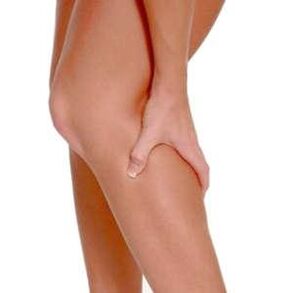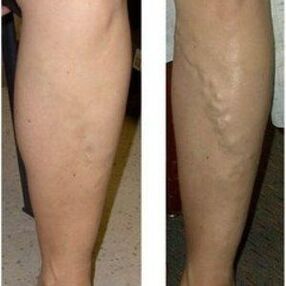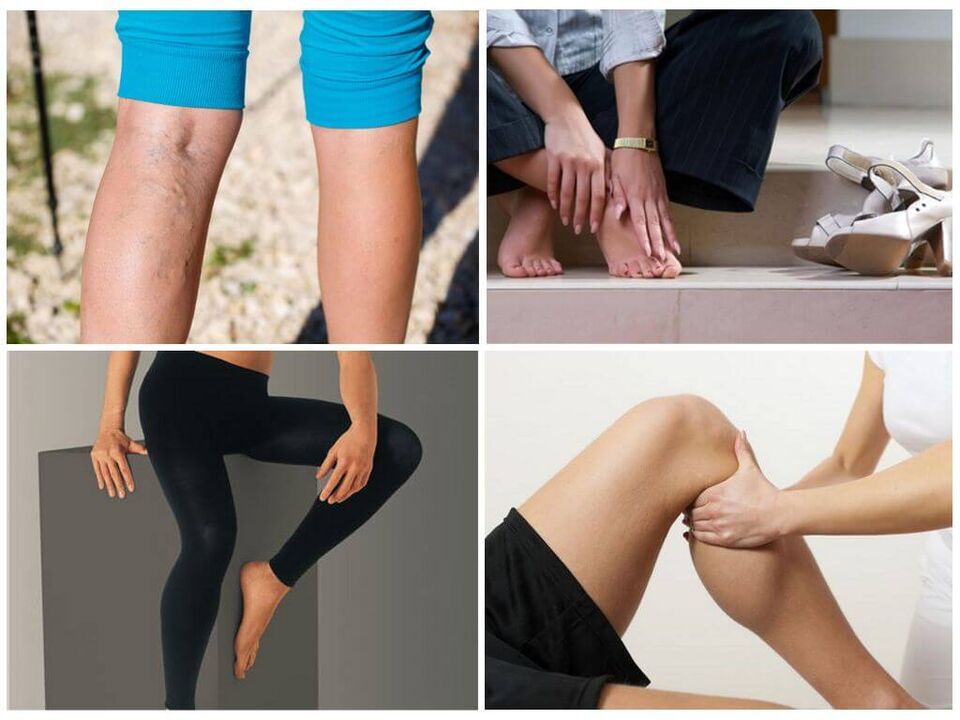The varicose vessels in the legs are often susceptible, since the lower extremities are a great load every day. Several forms of this pathology are observed in every 3 women and in every 5 men.

The disease is characterized by certain clinical manifestations and complications that can significantly affect the ability to work and level of quality of life. In addition, we will talk about varicose veins in the legs and everything related to this phenomenon.
What are varicose veins?
Varicose veins in the legs are a pathological state, accompanied by changes in the vessels (harp, increase in length, nodules formation) as a result of an inadequate operation of venous valves and deteriorated blood flow.
This disease has been known since ancient times, which is confirmed by numerous archaeological excavations.
Reference. Today, every 4 people on the planet suffer from such pathology.
The insidiosity of the disease is that 50% of people do not even know that they have the initial stage of the disease. More often, women are subject to such a disease due to the characteristics of the Perestroika course in the hormonal system.
To discover what varicose veins are in the legs, we turn to the characteristics of the anatomical structure and the physiological processes of the circulatory system.
Vienna: vessels through which blood flows from the organs of the body to the heart. But the arteries carry blood in the opposite direction, from the heart muscle to tissues and organs.
Unlike the latter, the veins have a small part of the muscle tissue, therefore, the unilateral valves have valves on one side to avoid a reverse blood flow.
If for some reason, these valves stop working normally, thenThere is a blood torrent of blood, that is, it does not flow, as it should, but down.
As a result, a congestive phenomenon is formed: the blood accumulates in the legs and under its pressure the vessels begin to expand and deform.
The consequences of such processes will soon be seen in the feet with the naked eye. The bluish or bluish green lines, then that stand out above the skin surface, become remarkable under the skin.
With age, the pathological state is generally exacerbated, because it first develops quite slowly and then progresses rapidly.
Reasons

The causes of the varicose veins of the lower extremities are quite diverse. The scientists dedicated a lot of time to the study of this problem, not characteristic of other living beings.
Reference. Some believe that this is a type of compensation of humanity for possessing the possibility of simplicity, as a result of which the legs experience great pressure from all body weight.
In addition, experts determined a complete list of factors due to which varicose veins appear on the legs. These include:
- Inheritance-The risk of appearance is approximately 70%if one of the relatives had varicose veins. The ailment in itself is inherited, but the structure of the vessels, genetically determined: weak venous walls, lower valves.
- Inactive lifestyle- If a person moves little, then the tone of the blood vessels weakens, the pressure in the veins increases, the blood stagnates.
- Overweight- One of the most common reasons. At the same time, the risk of developing the disease increases in proportion to the increase in adipose tissue in the body.
- Excessive physical activity- The venous pressure increases repeatedly, if a person spends almost all day standing, especially when lifting weights.
- Violations in endocrine and hormonal systems- Refers to female sex, since hormonal failures become causes of stagnation. Such periods are pregnancy, postpartum time, menopause.
- Height shoes-They are in constant tension, so blood flow is altered through deep veins. As a result, the blood is rushing to the superficial veins, whose valves cannot deal with the load.
However, these are not all the reasons that cause the development of pathology. There is another point, which is from which the varicose veins and are associated with disorders in the nervous system and the psychological state of a person.
Psychosomatic of the varicose veins
Psychosomatic- An address in psychology, which studies the influence of psychological factors in the development of somatic (bodily) ailments.
For a long time it is known thatAll processes in the human body are controlled by a brain that is controlled by consciousness.
Therefore, it is believed that the causes of all diseases are in the head and are psychosomatic.
This means that the occurrence of health deviations causes internal experiences or exposure to stress.
Reference. In oriental medicine, it is believed that varicose veins are a psychosomatic disease.
The causes of the psychosomatic of varicose veins are such psychological states:

- stress;
- depression;
- stagnation, lack of objectives in life;
- neurosis;
- Long stay in difficult conditions for the psyche;
- A breakdown.
All this negatively affects the nervous system of the body and the following occurs.The elasticity of the walls of the blood vessels is regulated by the ends of the nerve fibers.
Under the action of such psychological factors, the nature of its activity is changing. As a result, the tone of the veins is reduced, the light increases in the vessels, which avoids the operation of the valves.
The therapy of the varicose veins, which arose on the nervous ground, requires a special approach and with the participation of several specialists from different profiles.
Symptoms
This disease is characterized by characteristic symptoms that are quite easy to determine.
The initial symptoms of venous circulatory disorders are:
- Heaviness, pain, burning sensation, itching.
- Numbness, rare cramps at night.
- The appearance of a vascular mesh of a bluish red color.
If it does not detect or begin the therapy of such pathological processes, the ailment will continue its progression and new ones will be added to the existing symptoms: new:
- The appearance of the seal in the leg with varicose veins, the skin begins to take off and cover with spots;
- pain in the muscles that increase when walking;
- the manifestation of venous nodes that stand out on the surface of the skin;
- A feeling of pressure pain with the fingers in the veins.
In addition, you can see the swelling of the legs, which is a serious warning about the dynamic development of the disease, since deep veins can no longer deal with their work.
Reference.Lack of treatment can cause the development of complications in the form of thrombophlebitis, trophic ulcers, bleeding.
How varicose veins are developed
Previously, it was considered a mechanism for the development of venous expansion of the veins in the legs, which consists of the incorrect blood flow (below) due to special valve work disorders.
As a result, the symptoms of pathology characterized by the development sequence are manifested.
The manifestations and the course of the disease in each individual case have their own characteristics, which depend on the patient's age, their health and the cause of the development of the phenomenon.

On the feet
The disease passes several stages of development: from minor signs to extensive veins in the legs and sensations of pain.
Doctor of Medical Sciences V. S. Savelyev systematized the stages of disease development, depending on the rate of progression and body's ability for autoalteo.
Visual change in the lower extremities as a result of the development of varicose veins
In total, he identified 3 stages of the disease course:
- Compensation stage- There are no pain or completely insignificant, edema after loads, vascular stars.
- Subcompensation stage- Pain, fatigue, cramps, swelling at night, a feeling of exploding on the legs.
- Decompensation stage- The restoration of the skin (even long -cooked small wounds) is disturbed, veins are enlarged on the legs, severe pain and discomfort.
In the decompensation stage, all body systems suffer:The weakening of bone and muscle tissue occurs, hair begins to fall.
Do not delay treatment, giving pathological processes to go through all degrees of development. The sooner the therapy begins, the more effective it is.
On the feet
There is no diagnosis of varicose veins in the international classification of diseases, however, it is often manifested in this part of the leg.
Reference.Very often, the varicose disease of the lower extremities begins with the feet.
The development of such a problem in the feet occurs almost in the same way as in the rest of the legs, with the exception of several points.
At first there is a slight swelling of the footThat it is rarely noticeable. With another course, it is addedPain and a feeling of exploding in the thumb.
It also appearsfireWith prolonged walk.
If nothing is done at this stage of development, the disease will progress even more with the appearance of a vascular mesh on the internal or external side of the foot and the expanded blue veins.
Reference.Varicosis in the foot of the legs may even appear at an early age.

If you do not take the necessary measures, the disease will go further, appearing on the legs, calves, hips.
Conclusion
Since this disease is very common, it is worth knowing everything about varicose veins: from development characteristics to symptoms and causes.
Such knowledge will help not only in time to determine and begin treatment, but also to prevent the appearance of pathology.
























